Mercedosaurus Rex at Indianapolic Park
Part 7: The Speedway narrowed, its speeds lowered
Author
- Henri Greuter
Date
- September 22, 2009
Related articles
- March-Alfa Romeo 90CA - Fiasco Italo-Brittanico, by Henri Greuter
- March-Porsche 90P - The last oddball at the Indianapolis Motor Speedway, by Henri Greuter
- Penske-Mercedes PC23-500I - Mercedosaurus Rex at Indianapolic Park, by Henri Greuter
- Introduction
- Part 1: Penske Racing at Indianapolis - new standards
- Part 2: Ilmor Engineering at Indianapolis
- Part 3: Mercedes, Benz and Mercedes-Benz at Indianapolis up until 1993
- Part 4: Equivalency formulas - waiting for things to go wrong
- Part 5: Stock blocks - keeping them rolling and promoting 'Born in the USA' technology
- Part 6: Indianapolis 1991 - Chevy And Rich Team owners
- Part 8: The forerunner
- Part 9: Pre-May '94 plans
- Part 10: Penske PC23 - a home for the engine
- Part 11: The 1994 Indycar season until mid-April
- Part 12: The unfair advantage and when others have it
- Part 13: Practice during the 1994 'Month of May'
- Part 14: Other bespoke-design 209s
- Part 15: From the last weekend of May '94 to the end of the season
- Part 16: Could the Mercedes Benz 500I have been stopped in time?
- Part 17: Creating an extinct species without it being forbidden, initially at least
- Part 18: The 1995 '500' - Did the Mercedosaurus bite its masters after all?
- Part 19: A possible twist of fate for Rahal-Hogan and Penske as a legacy of the 500I
- Part 20: Re-evaluation of our verdict
- Part 21: PC23's further active career after 1994
- Part 22: USACís points of views and some answers
- Part 23: The loose ends that didnít fit in anywhere else and the epilogue
- Part 24: "Plan your work; work your plan" - Chuck Sprague on the PC23
- Appendix 1: Specifications
- Appendix 2: Car and driver appearances and performances during the Month of May 1994
- Appendix 3: Chassis, entry, practice and race numbers in 1994
- Appendix 4: PC23's 1994 results sans Mercedes Benz 500I
- Appendix 5: PC23's 1995-'96 results sans Mercedes Benz 500I
- Appendix 6: A reflection on the PC23 chassis used by Team Penske in 1994
- Appendix 7: A review of Beast by Jade Gurss
Where?Indianapolis When?1993 Indianapolis 500 |
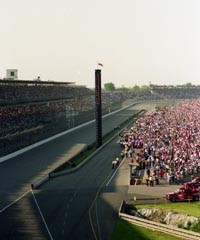 |
Why?
By 1992 the Buick stock block program had really got off the ground and Lola learned what it took to make a decent handling car around it. But with the Cosworth DFX (originally Ford-supported) and its short-stroke DFS derivative having become obsolete against the Ilmor-Chevy, Ford ordered Cosworth to build a brand new CART engine: the Ford XB - a revolutionary engine, far more compact than the old DFX/DFS and the Ilmor. Due to its much smaller frontal area Lola could build a version of their 1992 challenger with an even smaller frontal area and a far lower engine cowling compared to the cars built to take Ilmor or DFS/DFX engines and their versions specially built for the Buick V6. Also, the Ford XB-powered cars had less air resistance and a more effective rear wing, meaning that the 235 barrier came in sight.
The 230mph barrier tumbled that year, courtesy of the four Lola-Ford XBs entered (Newman-Haas entries for Mario and Michael Andretti, Target Ganassi entries for Eddie Cheever and Arie Luyendijk) and the Kenny Bernstein Lola-Buicks driven by Jim Crawford and Roberto Guerrero. The 235 barrier remained untouched.
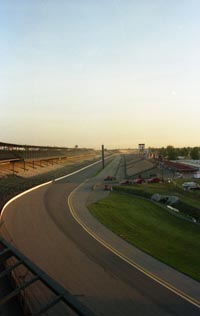
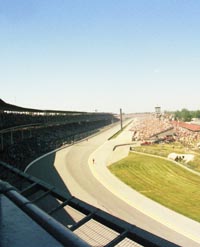
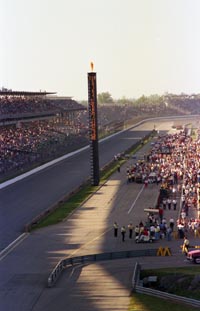
Sitting high in the early part of Turn One, this is what the track looked like in 1988. This lay-out remained pretty much unchanged until after the 1992 race. (photos HG)
Another irritation to Speedway officials in recent years was that drivers dropped below the white line at the inside of the corners, cutting off the track and going faster as a result.
All of this combined caused the Speedway to get to work after the 1992 race. A major redesign of the turns was undertaken. To prevent drivers from cutting the corners, the inside of the speedway turns were repaved. And instead of a white line only, the line was profiled with marker stones. If a car drove across this rumble strip, it would give less grip and shake the chassis. In short, you didnít want to drive over those stones.
In addition, the asphalt on the infield side of the white strip was removed and replaced with grass, making it impossible for the drivers to run inside the white line. The length of the track hadn't changed at all but effectively the turns had indeed been narrowed as a result. Because of that, the drivers were forced to make sharper turns, the radius having been made a bit smaller, causing the drivers to lose some speed.
Although it was no longer possible to drive on the inside of the white line, for safety reasons the track was given a proper warm-up lane inside the corners, separated from the track by a grass strip. This had the intention of allowing cars that had to slow down for whatever reason to leave the track before entering the turn and no longer endanger the competition at racing speed. Equally, a car leaving the pits and still building up speed was also kept away from the cars at speed. This was a safety measure that was well received.
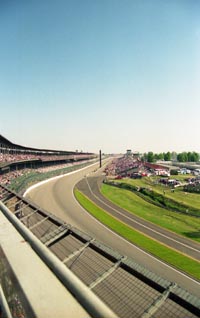
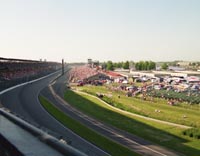
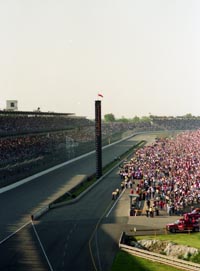
Sitting high in the early part of Turn One again, this is what the track looked like in 1993. Though taken at different moments on the day, a comparison with the old situation is well possible. (photo HG)
Additional aerodynamic restrictions also slowed the cars down but the reduced corner width was the main factor responsible for the reduced speeds. Only a very few drivers managed to break the 225mph barrier in 1993. The pole speed went down to a 223+.
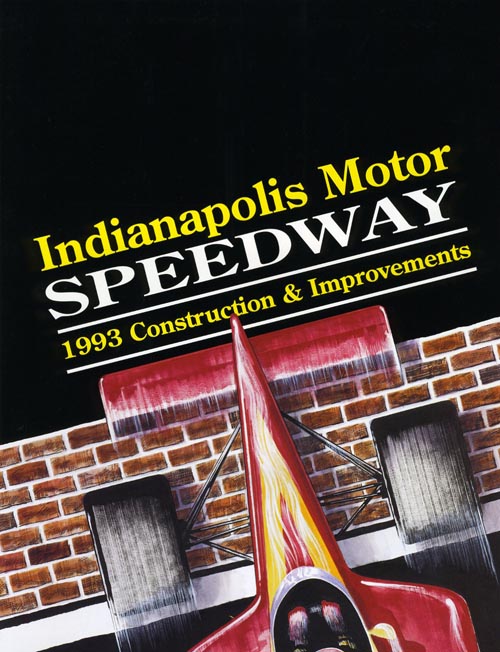
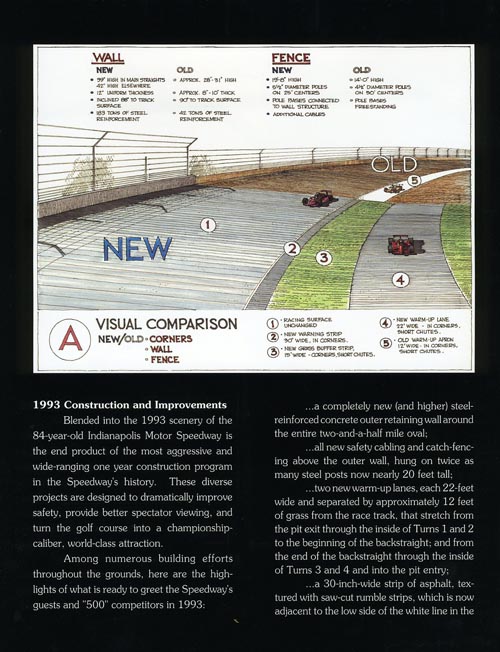
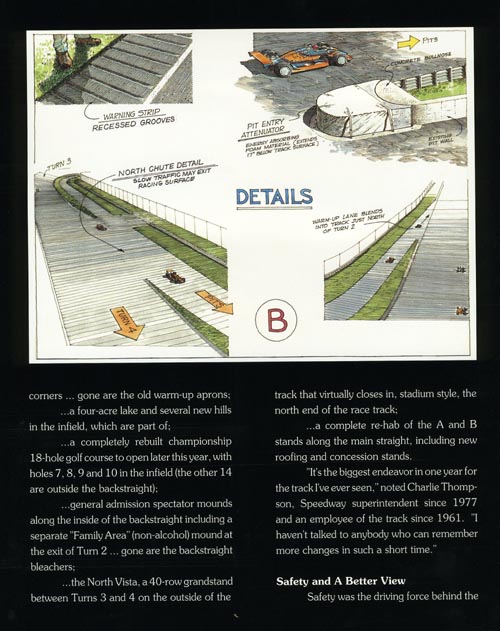
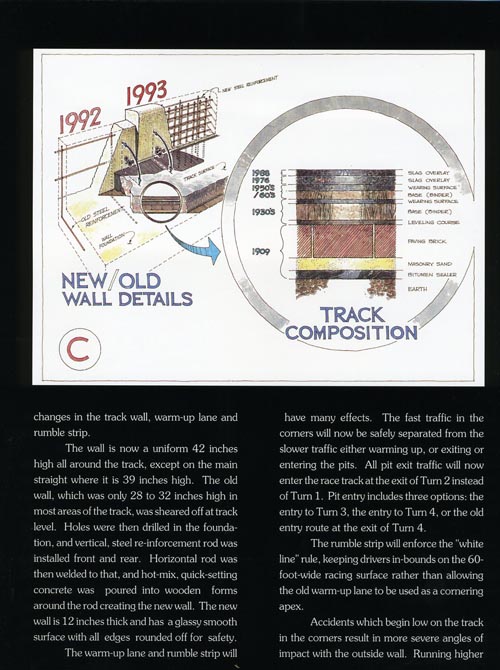
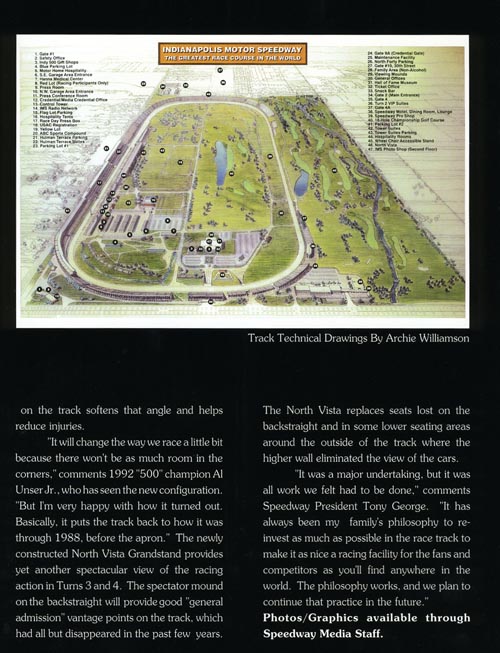
The Indianapolis Motor Speedway press kit contained an 8-page double folded pamphlet detailing the newly constructed corners. Here are the pages with the accompanying drawings.
Race Day í93 proved something else as well and it came as a bit of a surprise. With the narrowed corners and their reduced radius, all of a sudden the Speedway had become a 'one-lane track'. It was only possible to drive fast on the ideal racing line and now there was only one such line. Overtaking in the turns had become far more difficult if not impossible.
The 1993 Buick-derived Menards maintained their power advantage but the narrowed track was creating havoc for them. The Buicks had impressed in 1992 with high practice and qualifying speeds. But as the top Buick-powered team, Team Menard did less well in 1993, despite yet another bespoke chassis developed by Lola. The engine wasnít flexible enough to cope with the bigger differences in engine rpm's in between corners because of the lower cornering speeds and the need to accelerate on the straights. Besides that, Race Day reliability still wasnít up to par. Al Unser Sr had been the only driver ever managing to bring home a Buick-powered car the full 200-lap distance in 1992 when he finished 3rd that year.
The entire situation in shortÖ
From 1993 on, with the new track lay-out, drivers had to use the straights again to pass their opponents. This meant increased top speed without sacrificing too much cornering speed. Gaining speed obviously meant having more horsepower.
However, with nearly every regular CART competitor using pure-bred quadcam racing engines, what was there to gain against the opposition? If anybody was able to overcome the handicaps of the potentially far more powerful pushrod, it would be an entirely different matter. With the requirement gone of a pushrod engine needing to be a production-based derivative, the loophole was there to be exploited for anyone who wanted to.
That is, if any of the competitors indeed realized there was a loophole to begin with...
